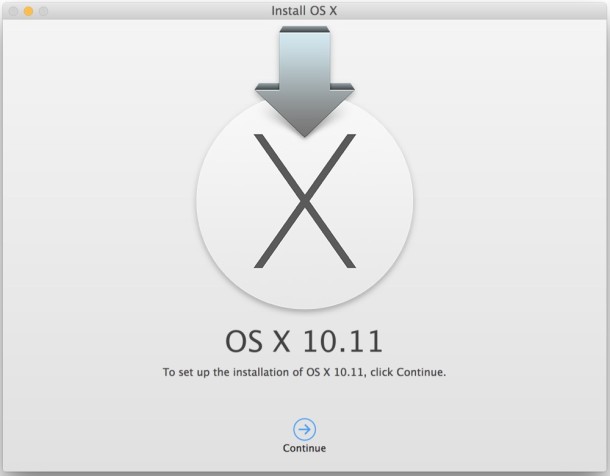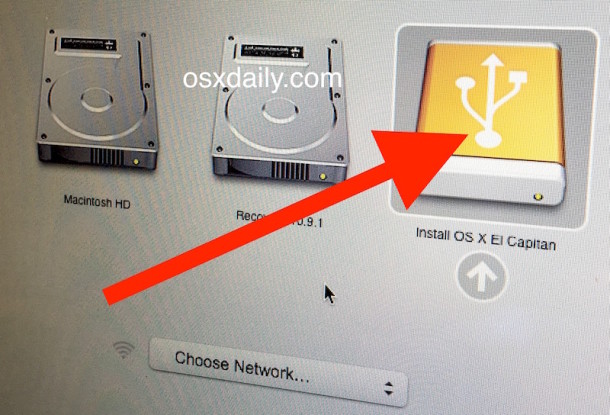
Install el capitan from usb drive Driver File Name: install-el-capitan-from-usb-drive.exe Driver Upload Date: 16 December 2020 Last Driver Version: 8.9.7 Driver File Size: 13,425 KB User Driver Rating: 4.7/5. It installs an app named Install OS X El Capitan into your Applications folder. A bootable installer doesn't. Aug 21, 2019 For a clean install, at first, you will need a bootable version of OS X El Capitan installer. After getting a bootable drive or device follow the steps to boot-Insert the device containing os X El Capitan installer. ILamourCar Bootable USB Stick for mac OS X El Capitan 10.11.6 USB Flash Drive for Full OS Recovery, Upgrade Reinstall System Install USB 16GB, Green. 4.3 out of 5 stars. Get it as soon as Tue, May 25. FREE Shipping on orders over $25 shipped by Amazon. The OS X 10.11 El Capitan installer from the Mac App Store in your Applications folder. The installer will delete itself when you install the operating system, but it can be re-downloaded if. Now Create bootable USB for Mac OS El Capitan on Windows. Now it is the time to create a bootable USB installer using TransMac, To install Mac OS El Capitan on VirtualBox on Windows 10 you need a Bootable USB here you will learn the steps of creating a bootable USB installer for Mac OS El Capitan on Windows.
*Quick note from Save Apple Dollars - Older OS X Images can now be downloaded directly from Apple at https://support.apple.com/en-us/HT211683 please right click on the image link and select “save as”.
By Roman Loyola at www.macworld.com
Senior Editor, Macworld | JUL 3, 2017 1:32 PM PDT
Apple uses its App Store to distribute its software, like new Mac operating systems. It’s convenient, but sometimes it can take a while for a download to finish. And if you have multiple Macs, it’s inefficient to download the new OS to each and every Mac.
That’s why I like to make a bootable external drive for the sole purpose of installing the Mac operating system. When I need to tend to a bunch of Macs, it’s much faster to use a bootable drive instead of going to each Mac, launching the App Store, searching for the operating system, downloading it (after entering my Apple ID), and then running the installer.
You can create a bootable USB flash drive with the macOS Sierra installer that’s now available. The installer software will take up nearly 5GB of storage space. Here’s how to create a bootable macOS Sierra installer drive.
Macworld also has bootable-install-drive instructions for:
Lion (OS X 10.7)
Download the macOS Sierra installer
Launch the App Store app, then look for macOS Sierra in the store. (Here’s a link.) Click on the Download button, and your Mac will download the installer to your Applications folder. If it automatically launches after download, quit the installer.
Keep the installer in the Applications folder.
If you’ve already upgraded your Mac to Sierra, the installer is removed from the Applications folder. You can download it again if you go to Purchased in the App Store. Look for macOS Sierra in the list of apps that you’ve bought, and click on the Download button. If it automatically launches after download, quit the installer.
Get an external drive
You can use a USB flash drive or a hard drive with room for the installer software. I’ve used different drives with success, including a VisionTek 120GB USB 3.0 Pocket Solid State Drive ($83 on Amazon) and an old 8GB Iomega Micro Mini Hard Drive.
Don’t worry if the drive isn’t formatted for the Mac. The drive will be reformatted automatically as part of the process. Change the name of your drive to Untitled; you need to do this for the steps below.
El Capitan Usb Installer Download
The quick and easy way
The process detailed below involves the Terminal. If your really don’t want to use Terminal, there are a couple of free apps you can use.

Install Disk Creator is a straightforward way to create a boot disk. I was able to make a macOS Sierra external USB boot disk in a few minutes, and the installation worked without a hitch. Also works with older versions of OS X.
Diskmaker X is a popular app. It also supports older versions of OS X.
Use the Terminal to create a boot disk
So you have your external drive, and the Sierra beta installer is in place. Now you’re going to use Terminal to create a boot drive. If you’ve never used Terminal before, don’t worry. This is pretty easy.
Here are the steps to create a macOS Sierra beta boot disk. (Apple also has these instructions.)
Connect the external drive to your Mac. (In the Terminal command you will use, I use
Untitledto represent your external drive. If your drive is named something else, you need to changeUntitledto the name of your drive.)Launch Terminal (/Applications/Utilities/Terminal.app).
Copy the following:
sudo /Applications/Install macOS Sierra.app/Contents/Resources/createinstallmedia --volume /Volumes/Untitled --applicationpath /Applications/Install macOS Sierra.appGo back to Terminal and paste the copied code at the prompt.
Terminal will ask for a password. This is your user password. Terminal doesn’t display characters when you type it in. Hit Return.
Terminal will tell you that it will erase your drive. To confirm that you want to continue, type Y and hit Return.
You’ll see that Terminal erases your drive. When that part is done, your Mac may ask you if you want to use the drive for Time Machine. Click Don’t Use.
Terminal will copy the installer file to your drive. This will take a few minutes.
After copying, Terminal is done. You should see Terminal display a “Copy complete” and Done notice. You can quit Terminal and your drive is ready for use.
How to boot from the installer drive
Plug your external drive into your Mac.
Power up (or restart) your Mac. Press down on the Option key while the Mac boots.
After a few moments, your Mac should display the Startup Manager, which will show you the available boot drives. Click on the external drive and hit Return. (You don’t need to select a network to proceed.)
Your Mac will display an OS X Utilites window. If you want to install Sierra and leave the data intact, select Install OS X. If you want to start over and wipe out the data, you need to go into Disk Utility to reformat the internal drive first, and then install macOS Sierra.
Full Credit for this article is given to Roman Loyola and www.macworld.com please visit their website for more helpful information about fixing Macs.
Created a bootable USB with El Capitan installer
booted from it, erased my MBP (mid 2009), clean install from USB installer
decided to use migration assistant, most apps not working plus all the clutter from pre clean install
decided to do another clean install but MBP won't boot from USB and uses the recovery version instead.
tried to get Maverick back and basically ended up with a non-working MBP that went into a boot loop
did a reinstall from MAS, ended up DLing the entire Installer again, went to bed and in the morning and 'working'
MBP again, plus all the clutter and non working apps.
Made a new bootable USB key using terminal and yes it finished and yes it said bootable at the end as well as in Disk Utilities.
However when trying to boot from USB, start+Option, or start+cmd+r still no sign of the USB stick, which i guess would leave me
with a non clean install again.

Any help, suggestions.....?
Os El Capitan Installer
Cheers
Ralf
Usb El Capitan Installer
MacBook Pro (13-inch Mid 2009), OS X El Capitan (10.11)
Posted on Oct 4, 2015 7:57 AM